This beef tenderloin recipe is an effortless, melt-in-your-mouth, show stopper dripping with so much flavor you will be obsessed. It is celebration, special occasion and holiday worthy (perfect for Valentine’s Day and Christmas!) and is foolproof as long as you have a meat thermometer. To make this elegant yet easy recipe, the beef tenderloin is enveloped in a robust spice mix, seared to golden brown perfection, slathered with garlic herb butter and baked to 5- star juicy splendor. The beef tenderloin is seeping with tantalizing buttery garlic herb flavor that’s complimented by a bright, cooling horseradish cream sauce you will want to put on everything – and it takes 60 seconds to whisk together! As much as you love this beef tenderloin the day off, it makes fantastic leftovers as well – because it’s so tender! I’ve included detailed instructions, tips, tricks and everything you need to know to cook the BEST beef tenderloin recipe!

PIN THIS RECIPE TO SAVE FOR LATER
Deliciously tender Beef Tenderloin Recipe
With Valentine’s Day this Sunday, I have been sharing some of my favorite elegant recipes including Tuscan salmon, brown butter gnocchi (coming Thursday), crème brûlée and now this beef tenderloin recipe! (You can check out all of my Valentine’s Day recipes at a glance here.)
What Is a Beef Tenderloin?
If you aren’t familiar with beef tenderloin, maybe you’re familiar with fillet mignon? Beef tenderloin is where the fillet comes from and truly lives up to its name. It is the most tender cut of beef and boasts a succulent, almost buttery tender texture. Even the leftovers are melt-in-your-mouth fabulous! Yes, beef tenderloin is pricey, but worth every penny and you can make a 5-star meal that will serve a crowd for way less than any 5-star restaurant – with equally delicious results!
We love to make this beef tenderloin recipe for special occasions and the holidays because not only does it serve a large quantity of people, it requires little hand’s on prep and can be prepped 100% ahead of time so all you have to do is pop it in the oven for about 20 minutes for a stress free win! With a good meat thermometer, you and yours will be sinking their teeth into perfectly cooked, fool proof, restaurant fabulous beef tenderloin.
In this beef tenderloin recipe, the beef is sliced in half to create two large roasts, rubbed with seasonings, seared until golden, then bathed with garlic herb butter then baked while the butter creates a self-basting butter sauce. The emerging beef tenderloin is sensationally flavorful, rich and buttery, and velvety tender. I CANNOT wait for you to try it!
Beef tenderloin is the most tender cut of beef that melts in your mouth when cooked correctly. Here’s a closer look:
- Where is beef tenderloin from? The beef tenderloin is a long cylindrical muscle in the cow which runs along the rear portion of the backbone. It sits between the top sirloin and the bottom sirloin and extends towards the short loin.
- What does beef tenderloin look like?: A whole beef tenderloin has a similar shape to a pencil, with a thick end known as the “butt” which tapers into a small, thin end known as the “tail.” The tail starts a little past the ribs and grows in thickness towards the butt of the cow. The beef tenderloin can be sold either “unpeeled” with the silverskin intact or “peeled” with the silverskin removed.
- What does beef tenderloin taste like?: The beef tenderloin comes from a muscle that performs very little exercise or even exertion so it is by far the most tender cut of all beef with a melt-in-your-mouth texture. Beef tenderloin also contains very little marbling, making it a very lean cut with a mild beefy flavor so it is often served with some kind of big, punchy flavor added such as garlic herb butter and horseradish sauce like in this recipe or a bacon wrap, pepper crust, or red wine sauce.
- How to cook beef tenderloin?: Beef tenderloin can be cooked whole, as roasts or as steaks. The whole beef tenderloin as well as the butt and center cuts are quite thick, so the the best way to cook them is to sear the outside, then finish cooking in the oven to medium-rare. You don’t want to overcook beef tenderloin because it doesn’t have a lot of fat and can dry out more easily. The tail is best sliced or chopped before cooking.
- What are other names for beef tenderloin?: Beef tenderloin is the whole muscle from which different cuts (and their various names) come from such as filet mignon, Châteaubriand, fillet, tenderloin steak and boneless butt tenderloin. It’s also a portion of the T-bone or porterhouse steak as well. See the section below for a more in-depth look.
- Where cuts come from beef tenderloin?: There are three main “cuts” of the tenderloin: 1) the butt (wide end), 2) the center-cut (middle section) and 3) the tail (tapered end). The butt end is quite thick so it is usually sold as boneless butt tenderloin and cooked as a roast or as steaks. It is also fabulous for carpaccio because it is so tender. The center-cut has the most uniform diameter and therefore used for medallions such as chateaubriand (larger center portion), tournedos (smaller central portion) and filet mignon (just above the pointy tail). The center cut is also what beef Wellington is made of. Lastly, the tail is the narrowest cut and tapers in shape so it’s most suitable for recipes requiring sliced or chopped tender steak such as beef stroganoff, pho, stir fries, hors d’oeuvres, and kabobs.
- Why is beef tenderloin so expensive? Beef tenderloin is anomaly in that it is the most tender cut of beef with an almost buttery tender texture and it is the leanest which makes it a prize cut of beef which demands a high price.

How and where to purchase Beef Tenderloin
If you’ve never purchased beef tenderloin, you might feel a little intimidated, especially because it is such a pricey cut of beef. I am here to arm you with what you need to know so you can get the best quality beef for your money. Here are three areas to pay attention to:
How Much Beef Tenderloin per Person?
A whole beef tenderloin is quite pricy, so you may be wondering, do I need the whole thing? It depends on how many people you are serving or if you like leftovers! This recipe is for a 4–5-pound whole beef tenderloin, but you can half the recipe if needed. As a general rule, you’ll want about ½ pound of meat person, which means this recipe will serve 8-10 people three to four (1/2-inch) slices. Of course, there are variables such as big or small eaters, children, etc., and what sides you are serving with the dish.
How do I halve the recipe?
If you would like to halve the recipe to serve four to six guests, then you will need one 2–3-pound center cut beef tenderloin. As previously discussed, the beef tenderloin can be broken down and sold in three different cuts – the center-cut is ideal to cook on its own because it is the most uniformly shaped so it will cook the most evenly and slice into beautifully medallions (it is the cut filet mignon comes from). If cooking only the center cut, then I would check the temperature after 15 minutes of cooking.
Should I purchase Whole or Trimmed Beef Tenderloin?
Typically, the grocery store will sell whole beef tenderloin either:
- whole/unpeeled: meaning the fat and silverskin are left on
- trimmed/peeled: meaning the fat is removed but the silverskin is left on
- PSMOs (“pismos”): short for peeled, silver skin removed, and side muscle (the “chain”) left on. In PSMOs you will only have to remove the fatty side strip.
The price per pound varies significantly between unpeeled and peeled due to the labor involved. Peeled cuts of beef tenderloin can be as much as $10 more per pound than unpeeled! As far as which one to buy? It comes down to your budget, time constraints and knife skills. Peeled beef tenderloin makes for an effortless dinner, whereas unpeeled, is the way to go if you if you are comfortable with a knife and are looking to save money over time.
Beef Tenderloin Roast Ingredients
In addition to the beef tenderloin, you’ll need ingredients for the simple spice rub, herb butter and optional horseradish sauce. There are a few ingredients going on but each component is made by simply whisking the ingredients together – SO easy! Here’s what you’ll need to make this beef tenderloin recipe:
THE BEEF
- Kosher Salt: Is a must for dry brining (more on that below) because its large texture doesn’t clump like table salt. I recommend Diamond Crystal brand kosher salt. The amount of salt you need will correlated directly to the size of your beef tenderloin. You will want ¾ teaspoon salt for every pound of beef. So, the simple equation is .75 x pounds of beef = teaspoons. If you want to convert to tablespoons, divide the teaspoons by 3. So, for a 4-pound beef tenderloin, you will want 1 tablespoon kosher salt.
- Vegetable oil: You MUST use vegetable oil or another neutral high smoking oil such as canola oil to sear the roasts. You cannot use olive oil or it will burn.
- Seasonings: In addition to kosher salt, the beef tenderloin roasts get coated in a generous rub of chili powder, pepper, paprika, garlic powder, onion powder to create a delicious crust of flavor. If possible, use freshly cracked black pepper for the best flavor.
Garlic Herb Butter
- Butter: Is softened just so it’s spreadable then used as the base to our garlic herb butter. I recommend using unsalted butter because there is already salt in the spice rub – you don’t ruin your beef tenderloin recipe by making it too salty! You can add salt, but you can’t take it away!
- Herbs: Dried parsley, dried oregano, and dried thyme are mixed with the butter and garlic to make a flavorful herb butter that gets smeared all over the beef tenderloin roasts. I recommend dried herbs otherwise you need 3X the number of fresh herbs and the butter gets pretty clunky and hard to spread.
- Garlic: You’ll need 2 garlic cloves for the garlic butter. We don’t want too much because the rub already has garlic powder. I like using both fresh and powdered garlic because they permeate and flavor the beef differently.
- Prepared horseradish: Just one teaspoon adds a pop of tanginess to lighten the butter and make the herbs shine. It is also used the horseradish cream sauce below but if you prefer not to use it, substitute Dijon mustard instead.
Beef Tenderloin Recipe Variations
You can change the flavor profile of this beef tenderloin recipe by mixing up the seasonings or the sauce. Here are a few variations to try:
- Seasonings: Swap the seasonings for Cajun seasoning, Mexican seasonings or swap the herbs for rosemary and basil.
- Sauces: Serve with a red wine sauce, peppercorn cream sauce, balsamic cream sauce, classic gravy, mushroom gravy, caramelized mushroom sauce, peri peri sauce or even chimichurri.
- Toppings: Serve with browned butter sautéed mushrooms or caramelized onions.
- Crust: Try wrapping the tenderloin in bacon strips before searing or creating a peppercorn crust.

Prepping Beef Tenderloin
Now that you are the proud owner of a whole beef tenderloin, it’s time to prepare it for baking which involves trimming, tying, and cutting. It may seem like there are quite a few steps involved, but don’t worry, each one of them is relatively quick and easy.
If you have purchased an unpeeled beef tenderloin, you will need to remove the fat including the fatty chain and the silverskin or just the silverskin if the fat has already been trimmed.
- What is the chain? The fatty chain is a strip of meat that runs the length of the tenderloin. It is tender, appetizing meat, but it’s separated from the tenderloin by lots of fat and sinew that cooks up chewy so you don’t want to include it in your roasts. You can trim the chain meat after it’s removed and use it for another use or freeze it for later.
- How to remove the chain: First, use your fingers to break through the connective tissue holding that section to the tenderloin and peel it away, most if it will easily separate. Next, use the tip of a sharp knife to finish slicing through any remaining connective tissue – that’s it! My Costco peeled tenderloin didn’t have the fatty chain so I don’t have a picture to show you, but you can check out this helpful Youtube tutorial.
- What is silverskin? The silverskin is part of a sinew that runs the length of the beef on one side. It looks like thin, silvery fat. You will want to remove it before cooking because it doesn’t melt like fat does and can become tough and chewy when cooked and can ruin your expensive cut of beef!
- How to trim silverskin: There really isn’t anything special about removing the silverskin. Start by removing as much fat as possible from the tenderloin – you can even begin by pulling it off with your fingers. Underneath the fat you’ll see the silverskin. To remove, slip a sharp knife in between the silverskin and the meat close to the edge of the thickest part of the tenderloin to create a “tab.” Angle the knife so the blade is facing toward the silver skin way from the meat. Finally, hold the tab taught while you cut the silverskin with a sawing motion until it’s cut free.
How to cut beef tenderloin
The beef tenderloin tapers like a pencil, wide on one end (the “butt’) and narrow on the other (the “tail”), which means it will not cook evenly if left alone – you will have a juicy butt and a dry, overcooked tail. To remedy this, you will need to cut the whole beef tenderloin in half to create two small roasts and then fold the tail over and tie it to the main body of the roast so it’s an even thickness.
Two roasts not only cook more evenly but allow you to sear the beef (because it can actually fit in your pan!), and allow you to cook the roasts for different durations. This is helpful because the butt roast is larger and will likely require more cooking time. It is also helpful if you would like to cook the roasts to different temperatures – cook one medium rare and the medium so everyone in the house is happy.
To cut the beef tenderloin, you don’t want to just cut directly in the middle because we are going to be folding up the tail, so the tail end would be shorter than the butt end. Instead, fold up the tail so you can eyeball where the middle of the tenderloin is after the thin end is folded against the roast. This will give you two equal halves after the roasts are tied.
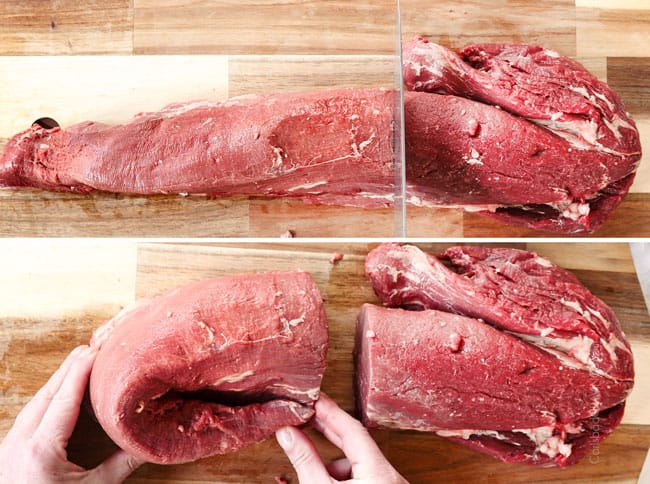
How to tie a Beef Tenderloin
In order for beef tenderloin to cook evenly and hold the folded tail in place, it is tied with kitchen twine – you can also ask a butcher to do this for you. The idea behind tying is to create as uniform roasts as possible.
To tie the tail roast, first, re-fold the thin end up against the roast to create a uniform cylinder shape. Next, you can simply tie individual loops spaced 1 ½ inches apart down the length of each tenderloin and then one loop going around lengthwise or follow the more proper technique below which is actually quicker (just more difficult explain, so just try it!):
- 1) Take a string and loop it around the width of one roast, about 1-inch from the end and tie a snug knot.
- 2) Loop the string around your left hand by moving the string from the front of your hand to the back so it creates a loop.
- 3) Move your same hand so it’s picking up the front of your roast and pull the loop around your tenderloin with the opposite hand and shimmy it down to create a loop 1 ½ inches from the first loop. Pull any loose string so it’s snug and repeat the process, tightening as you go.
- 4) To finish, wrap the string all the way around the roast lengthwise then tie off the end and trim any excess string.

The importance of dry brine on Tenderloin
Now that the beef tenderloin roasts are tied, it’s time to season. Dry brining sounds fancy but it simply means seasoning the beef with salt (and other seasonings) and chilling it uncovered in the refrigerator overnight up to 48 hours. If you don’t have time, you can just season and let it rest while it comes to room temperature – so don’t stress about this process!
Dry brining eliminates the moisture on the surface of the meat which promotes a spectacular seared crust and achieves the goals of traditional brining—deeply seasoned, juicy beef – without water logged beef.
How does it work? The salt in the dry brine achieves 3 goals:
- Deep seasoning: The moisture of the meat breaks down the water-soluble elements in the seasoning creating a glaze which you will be able to see sitting on the surface of the beef. The glaze eventually seeps back into the meat as the salt moves from an area of high concentration (the surface of the beef) to a lower concentration (inside the beef).
- Tenderizes: The salt breaks down the cell proteins so they can no longer contract when cooking which allows the cells to hold onto more water resulting in juicier beef.
- Golden crust: The salt helps achieve better surface browning – the hallmark of any well-cooked beef. The salts result in a quicker Maillard reaction and crispier crust because the surface of the meat stays drier during searing and cooking.
How to Cook Beef Tenderloin
Now the fun part! Now that the beef tenderloin is prepped, it’s time to cook! Here’s how:
- Season beef generously: The dry brining starts by drying the beef with paper towels then seasoning with a spice rub. Mix chili powder, garlic powder, salt, onion powder, paprika and pepper together then rub onto all sides of the roasts. We are going to hold the herbs and add them to the herb butter because we don’t want them to burn when we sear the beef.

- Chill beef: This is the second part of dry brining. Transfer the beef tenderloin roasts to a cooling rack placed over a baking sheet. Refrigerate uncovered for 12-48 hours. You can also refrigerate less than 12 hours; it just won’t be as affective- but it’s better than nothing!
- Bring roasts to room temperature: The beef must be at room temperature before it’s cooked or it won’t cook evenly. Set the beef tenderloin on your counter for about 2 hours before you plan on searing. If you haven’t dry brined the beef, then season it first and then let it rest for the two hours.
- Sear the roasts: Searing the beef creates the Maillard reaction resulting in rich, deep, complex flavor and locks in the juices which prevents the surface of the tenderloin from becoming dehydrated when cooked at high heat. To sear, heat 2 tablespoons vegetable oil in a large cast iron skillet over medium high-heat. When oil is very hot and just smoking, add beef tenderloins (you may need to work in batches). Sear each side of beef until deeply golden.
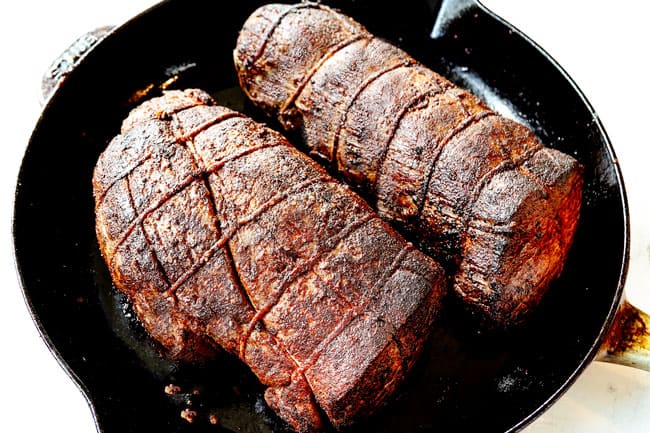
- Slather with herb butter: Because beef tenderloin is a lean cut of beef with little marbling, it is mild in flavor and prone to drying out. To remedy these shortcomings, we create a self-basting butter bath to promote extra juicy, flavorful beef. To make the garlic herb butter, stir together the softened butter, garlic, and fresh herbs. You can do this at any point while the beef is coming to room temperature. Next, slather the top and sides of the roasts with the butter – it will seem like a lot, but use all of it! As the beef tenderloin bakes, the butter will drench the beef with moisture and collect in the skillet to create a buttery pool, some of which will seep back into the beef, and the rest is used to baste the beef after it comes out of the oven – heaven!
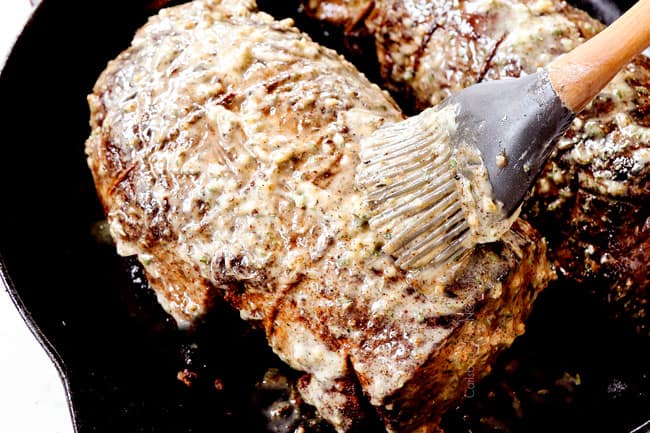
- Bake the beef tenderloin: Searing the roasts in a cast-iron skillet makes baking super simple – simply transfer the skillet to the oven and bake at425 degrees F for about 20 minutes. If you don’t have an oven proof skillet, you can use a lightly greased baking dish such as a 9×13 pan or roasting pan.
- Let the meat rest: Once the beef tenderloin comes out of the oven, let it rest for 15 minutes. This gives the juices time to redistribute evenly all over the beef and makes for the most tender beef tenderloin!
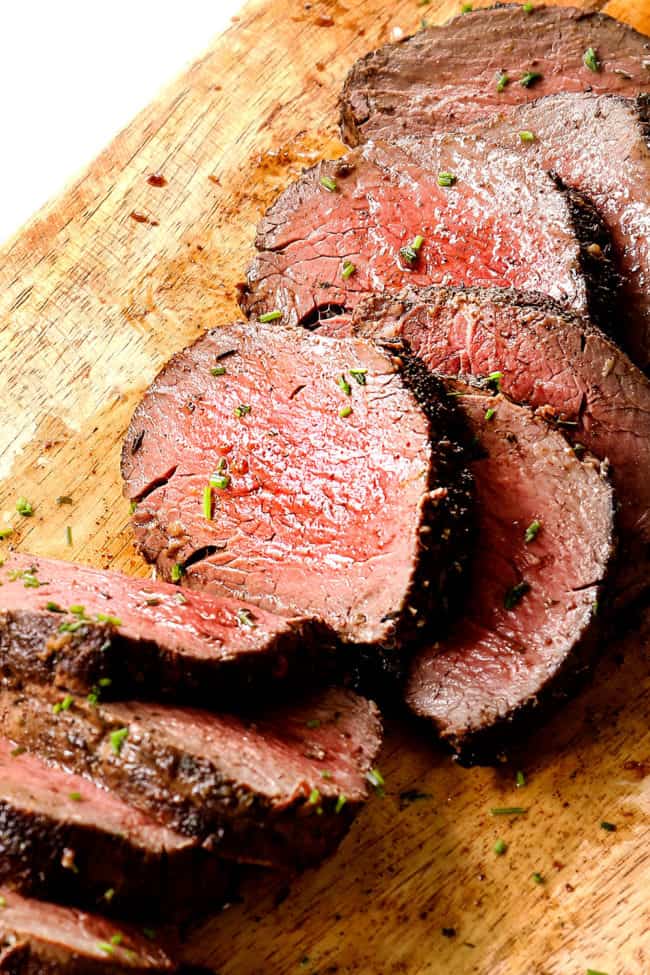
Perfect temperature for Beef Tenderloin in oven
Beef tenderloin is a very lean cut of meat so it requires a relatively high oven baking temperature, about 450 degrees F. Lower temperatures require longer cooking times (up to an hour) which dry out the beef. By cooking at a higher temperature, the meat is cooked through before it has time to dry out.
How long to cook Beef Tenderloin in Oven
The exact cooking time of the beef tenderloin depends on the actual size of the roasts and temperature you like your beef cooked. In general, the total cooking time including searing, roasting and resting will be around 50-65 minutes.
- Searing: will take about 9-12 minutes (about 3-4 minutes per side), depending on the actual heat of your skillet determined by the skillet material and how long the beef has been dry brined.
- Roasting: After searing, the beef tenderloin will roast for approximately 25 to 35 minutes in the oven for a total of about 20 to 35 minutes. Your thinner tail roasts might take closer to 20 minutes and your thicker butt roast might take closer to 35 minutes.
- Resting: After the beef tenderloin is finished cooking, it should rest for at least 15 minutes so the juices that push to the outside when cooking can be reabsorbed and redistributed all throughout the beef.
What Temperature Should Beef Tenderloin Be?
Beef tenderloin should be cooked medium-rare to medium. It shouldn’t be cooked to a higher temperature because it’s a lean cut of beef and can dry out if overcooked. Essentially, the higher the internal temperature, the more tough the meat will be.
Use the below temperature chart to gauge your beef tenderloin’s doneness, keeping in mind the beef will rise 5-7 degrees after resting, so take the meat out of the oven 5-7 degrees below the temperature you are aiming for.
- RARE – 115°F – 120°F
- MEDIUM RARE – 120°F – 125°F
- MEDIUM – 130°F – 135°F
To take beef temperature, insert the probe in the thickest part of the roasts. Keep in mind this means thinner slices towards the ends of the roast will be more cooked but the center will remain the exact temperature you’re aiming for. This is another reason to aim for medium-rare in the center so the ends won’t exceed medium.
Recommended equipment for cooking the perfect Beef Tenderloin
Last year I purchased a beef tenderloin and did the worst thing you can do to a pricey cut of beef – I overcooked it! My instant read thermometer was out of whack. I was determined not to do it ever again, so I purchased this digital probe thermometer, and it worked like a dream! You are welcome to use an instant read thermometer, but for 100% accuracy, I highly recommend this digital probe thermometer which retrieves temperature precisely to within ±1.8°f (±1°c ).
This digital probe thermometer has two probes so you can place a probe in each of the roasts. This is especially helpful when cooking a beef tenderloin because the two roasts can cook at different temperatures. My tail roast took 20 minutes to cook and my butt roast took an extra 15 minutes! The thermometer allows you to set the desired temperature for each probe and an alarm will set as soon as it reaches the set temperature.
Note, if you’ve never used a probe thermometer before, the LCD display does NOT go in the oven or barbecue! You insert the probes into the meat and weave the cables out of the oven and the magnetic back allows you to stick it on your oven door or you can use the flip-out countertop stand.
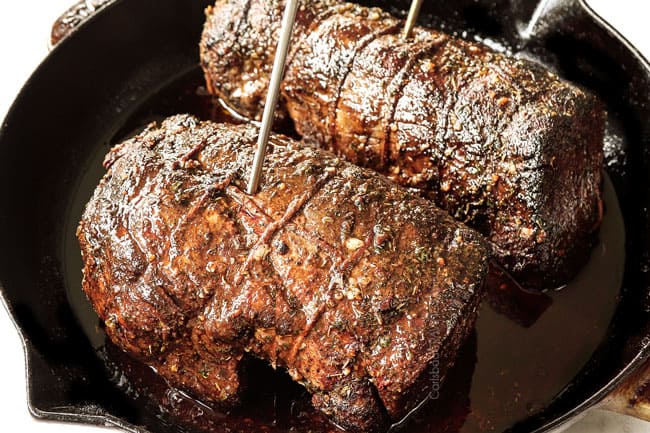
Best Beef Tenderloin Recipe Tips
- Refrigerate overnight: If possible, tie up the tenderloin then season it generously and let it rest in the fridge overnight. The beef will be more tender, flavorful and all that seasoning will form a flavorful golden-brown crust!
- Sear for flavor and moisture: Use a large cast iron skillet for the best sear. If you cannot sear both tenderloins without them touching, then you will want to sear in two batches. I clean out my pan in between searing each beef tenderloin roast so the second doesn’t get any residual brown bits that can burn. Take care to sear the roasts until deeply golden on all sides.
- Softened butter: Make sure the butter is softened but still thick so it’s spreadable and will stick to the tenderloin.
- Don’t overcook: Because beef is so lean, it can dry out very easily if overcooked. Use your meat thermometer and check your beef right at 20 minutes then every few minutes as needed to achieve the correct temperature. Better yet, use a digital probe thermometer, and set the desired temperature.
- Let the beef rest: Do NOT skip the resting period once the beef is pulled from the oven. If you cut into the beef right away, the juices will ooze right out and you’ll be left with a potentially dry beef tenderloin. Letting it rest makes the tenderloin ultra moist and juicy!
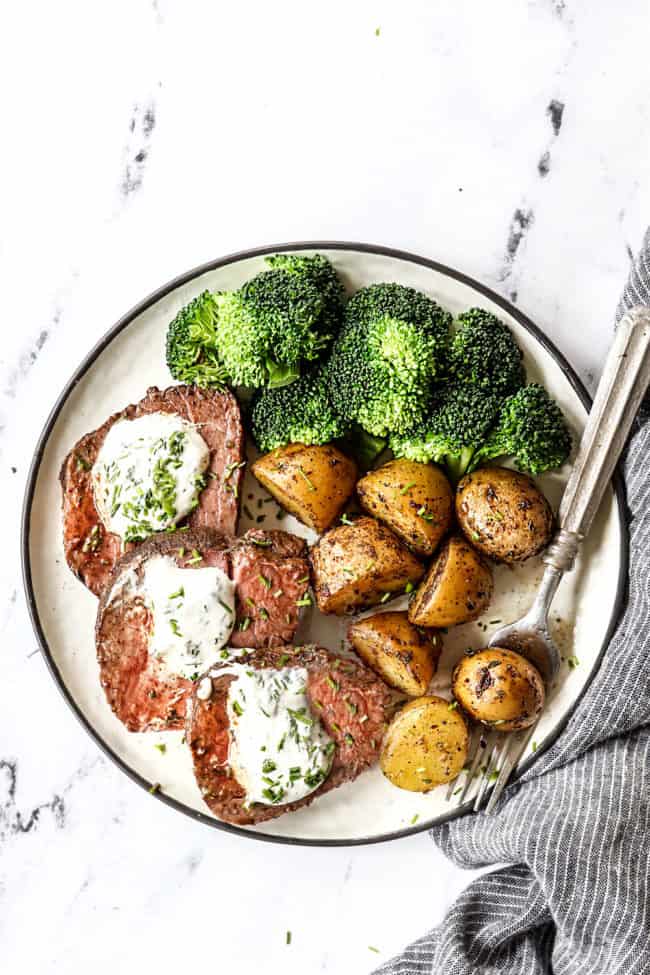
How to serve Beef Tenderloin
I originally planned on making some sort of warm sauce to accompany the beef tenderloin recipe such as black peppercorn or balsamic cream sauce, but after tasting the robust meat, I knew zesty horseradish cream sauce would be the perfect sublime counterpart.
The horseradish cream sauce is cool and creamy with a gentle heat and brightness from the lemon juice that beautifully balances, contrasts and cuts through the richness of the meat without overpowering it. Both my husband and I were obsessed with this sauce – and you will be too – it’s so good on everything!
You can customize the horseradish sauce just how you like it by adding more or less horseradish, more or less lemon juice or even red pepper flakes. It is also make ahead friendly and so easy – just whisk the ingredients together and you have a divine finishing sauce in minutes.
What to serve with Beef Tenderloin
We are a steak and potatoes bunch over here, so for me, nothing is better with this beef tenderloin recipe than Garlic Butter Mashed Potatoes! Of course, we’ll throw in a fantastic salad like Apple Salad and a veggie like Parmesan Asparagus and now you have a meal worthy of your spectacular beef tenderloin! Feel free to mix and match your sides with some of the tasty options below:
- Potatoes: Potatoes and steak go together like peanut butter and jelly! Try any of these potato favorites to complete your steak dinner: Company Mashed Potatoes, Slow Cooker Mashed Potatoes, Smashed Potatoes, Twice Baked Potatoes, Au Gratin Potatoes, or Roasted Pesto Potatoes.
- Risotto: If you’re more of a rice than a potato person, get your comforting carbs in the form of risotto! My risotto recipes are all baked in the oven so they are hand’s off, foolproof and SO EASY. And of course they taste divine. You’ll be drooling over Parmesan Risotto, Mushroom Risotto and Butternut Squash Risotto.
- Veggies: You can have your sheet pan veggies all prepped and ready to go then throw them in the last few minutes with the beef tenderloin to cook because the roasting times are very similar. Try Roasted Broccoli, Roasted Butternut Squash, Roasted Brussels Sprouts, Roasted Root Vegetables or Roasted Carrots, in the oven or Sauteed Brussels Sprouts, Glazed Carrots or Brown Butter Balsamic Asparagus on the stove.
- Salads: Wedge Salad and Green Bean Salad are always a classic with beef tenderloin. We also love Spinach Berry Salad, Strawberry Salad and Cucumber Tomato Salad in the spring and Apple Salad, Fall Salad, Roasted Butternut Squash Salad and Roasted Beet Salad in the winter.
- Fruit Salads: Perfect Fruit Salad, Creamy Grape Salad, Pina Colada Fruit Salad, Winter Fruit Salad and Berry Salad in Honey Mascarpone Dressing will amp up your fruit game!
- Casseroles: You probably don’t hear the word “casserole” and think gourmet, but these casseroles pair beautifully with this beef tenderloin recipe and will elevate any plate: Million Dollar Macaroni and Cheese, Zucchini Casserole, Green Bean Casserole, Potatoes Au Gratin, Sweet Potato Casserole.
- Breads: Another must with steak! You can go as simple as crusty bread or as fabulous as Perfect Dinner Rolls, Buttery Breadsticks or Garlic Bread.
- Dessert: There are too many fabulous desserts to list here, so I recommend checking out my dessert page. Some of my favorite special occasion desserts include Kentucky Butter Cake (I make this more than any other dessert), Crème Brulee, Chocolate Mousse Cake, Chocolate Raspberry Cake, German Chocolate Cheesecake and Red Velvet Cheesecake.


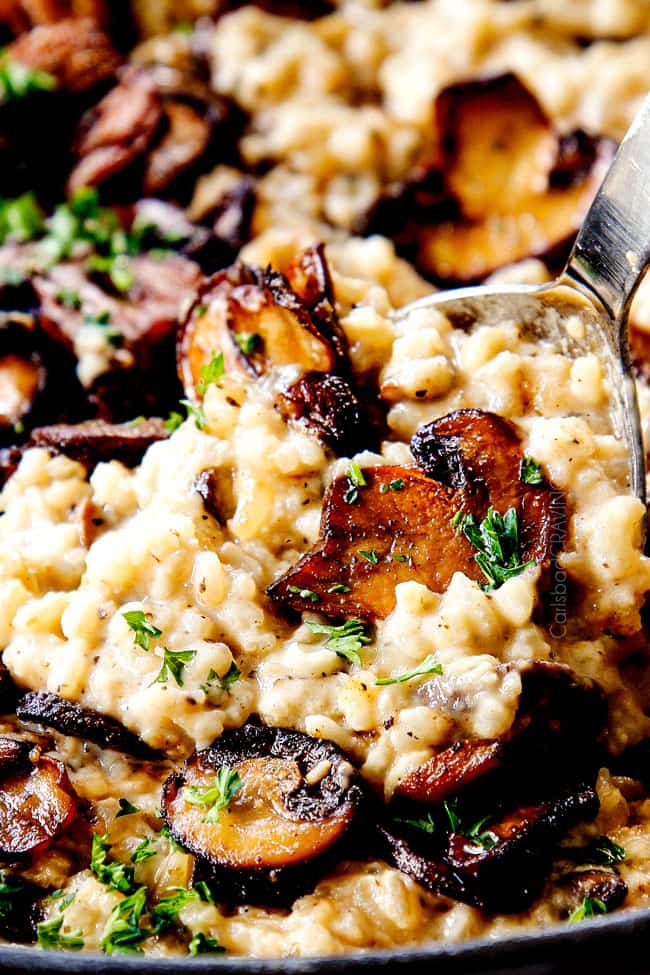

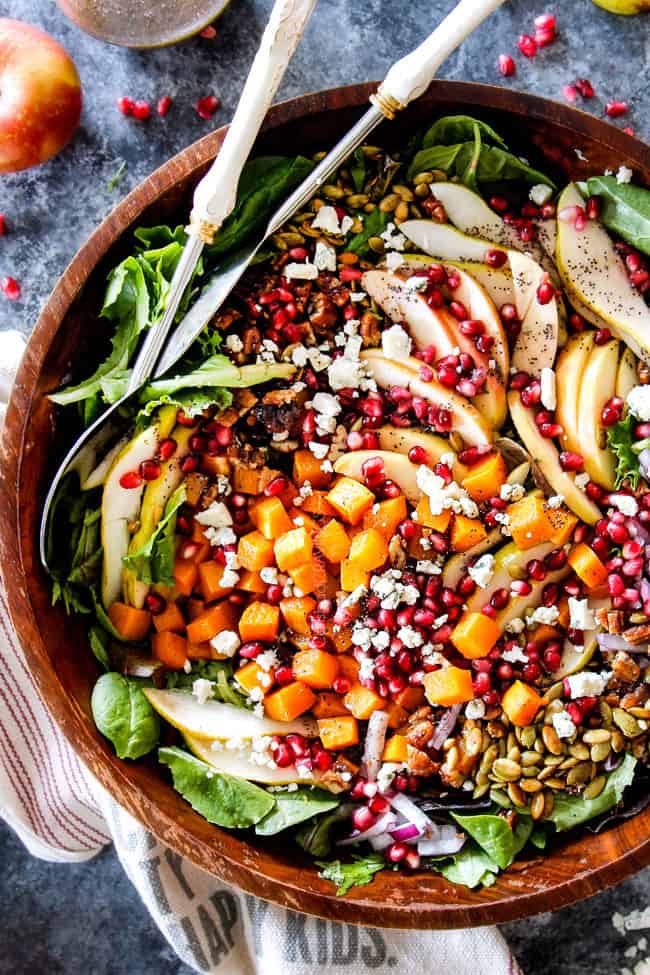

Storing leftover Beef Tenderloin Roast
Leftover beef tenderloin should be stored in an airtight container in the refrigerator. When properly stored, the beef is good for up to 5 days.
How to Reheat Beef Tenderloin
Beef tenderloin can be reheated in the microwave, skillet or oven. It reheats well if not initially cooked above medium. Make sure to slice the tenderloin before reheating it so it warms up quickly; you don’t want to accidentally dry out the outside of the meat.
- Microwave: Heat slices for 30 seconds then at 20 second intervals as needed.
- Skillet: Melt some butter in a skillet then add slied beef tenderloin. Heat just until warmed through.
- Oven: Wrap sliced tenderloin in foil and bake at 350 degrees F for 10 to 15 minutes, or until just heated through.
Can I Freeze Beef Tenderloin?
Yes! You can freeze beef tenderloin whole, chopped or in slices. Frozen tenderloin should be used within 3-4 months
Looking for More Beef Dinners?
- Balsamic Slow Cooker Roast Beef
- Beef and Broccoli
- Braised Short Ribs
- Crockpot Pot Roast
- Marinated Flank Steak
- London Broil
- Slow Cooker Beef Tips and Gravy
- Grilled Asian Steak
- All of my beef recipes!
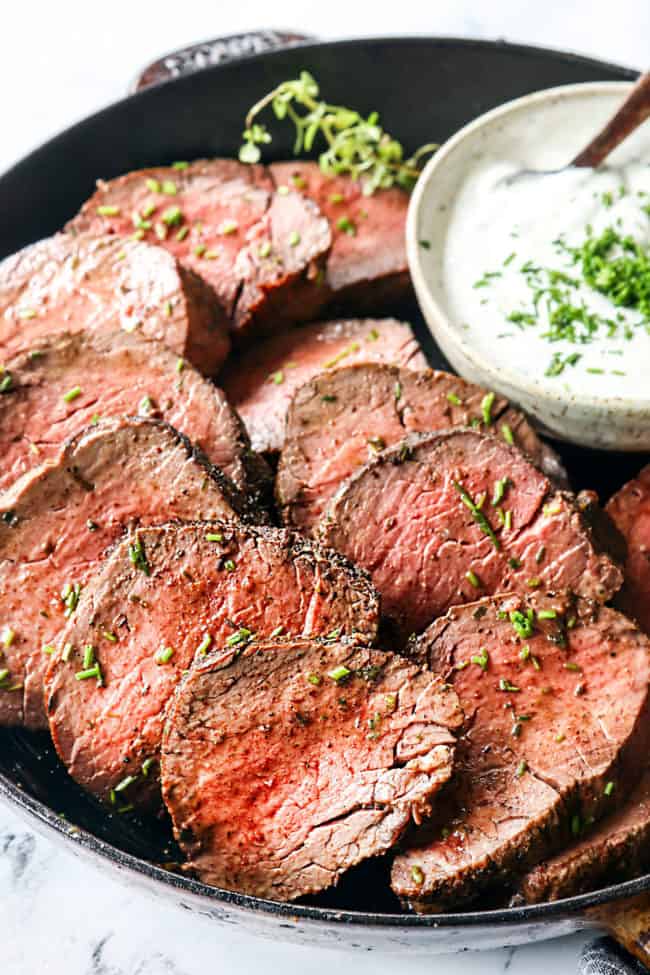
Want to try this Beef Tenderloin Casserole RECIPE?
Pin it to your Dinner, Beef, or Holiday Board to SAVE for later!
Find me on Pinterest for more great recipes! I am always pinning :)!
©Carlsbad Cravings by CarlsbadCravings.com
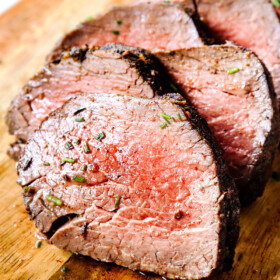
Beef Tenderloin Recipe
Save This Recipe To Your Recipe Box
You can now create an account on our site and save your favorite recipes all in one place!
Ingredients
- 1 4-5 pound beef tenderloin trimmed of silverskin and excess fat
- 2 tablespoons Vegetable oil
- Kitchen twine
Spice Rub
- 3-4 teaspoons kosher salt use ¾ teaspoon for every pound
- 1 tablespoon chili powder
- 1 tsp EACH pepper, paprika, garlic powder, onion powder
Garlic Herb Butter Spread
- 6 tablespoons unsalted butter
- 2 cloves garlic minced
- 1 teaspoon prepared horseradish
- 1 tsp EACH dried parsley, dried oregano, dried thyme
1 Recipe Horseradish Cream Sauce << Click for Recipe
Instructions
- CUT: One end of the beef tenderloin will have a thinner tapered end – we will be folding this end up against the roast. Cut the beef tenderloin in half so the two halves will be roughly equal length when you fold the thin end up against the roast to create a uniform cylinder shape (see photos in post).
- TIE: In order for beef tenderloin to cook evenly and hold the folded tail in place, it is tied with kitchen twine – you can also ask a butcher to do this for you. First, re-fold the thin end up against the roast to create a uniform cylinder shape if needed. To tie, you can simply tie individual loops spaced 1 ½ inches apart down the length of each tenderloin and then one loop going around the roasts lengthwise or I’ve detailed the proper technique below which is actually quicker (just maybe more difficult explain, so just try it! – see detailed photos in post):
- Take a string and loop it around the width of one roast, about 1-inch from the end and tie a snug knot. Loop the string around your left hand by moving the string from the front of your hand to the back so it creates a loop. With your looped hand, pick up the front of your roast and pull the loop around your roast. Shimmy the loop down to create a loop 1 ½ inches from the first loop. Pull any loose string so it’s snug and repeat the process, tightening as you go. To finish, wrap the string all the way around the roast lengthwise then tie off the end and trim any excess string.
- SPICE RUB: Whisk together all of the Spice Rub ingredients in a small bowl; set aside. Pat roasts dry with paper towels then evenly rub spice mix all over (it will seem like a lot but use all of it).
- BRING TO ROOM TEMPERATURE: Let roasts rest at room temperature for two hours or transfer to the refrigerator to rest uncovered for up to 48 hours. If the beef is refrigerated, let it sit at room temperate for 2 hours before cooking.
- HORSERADISH CREAM SAUCE: At any point while the roast is resting, mix all of the Horseradish Cream Sauce ingredients together in a medium bowl. Cover and refrigerate until ready to use. When ready to use, taste and adjust to taste if desired.
- GARLC HERB BUTTER: When ready to cook, preheat the oven to 450 degrees F. Meanwhile, mix all of the butter spread ingredients together in a bowl until evenly combined; set aside.
- SEAR ROAST: Heat 2 tablespoons vegetable oil in a large cast iron skillet over medium high-heat. When the oil is very hot and just smoking, add beef tenderloin roasts (you may need to work in batches). Sear each side of beef until deeply browned. Transfer to a plate and wipe out any blackened drippings. Drizzle skillet with oil and transfer roasts back to the skillet. Slather the butter spread all over the tops and sides of the roasts (use all of it).
- BAKE: Transfer the skillet (or use a lightly greased baking dish/roasting pan) to the preheated oven. Bake at 450 degrees F until beef registers desired doneness: between 120-125°F for medium rare, recommended (about 20-25 minutes) or 115-120°F for rare or 130-135°F for medium rare. **Keep in mind the beef will rise 5-7 degrees after resting, so take the meat out of the oven 5-7 degrees below the temperature you are aiming for. You will likely need to remove one roast before the other.
- REST AND SLICE: Remove skillet from the oven and baste roasts several times with the buttery juices from the skillet, then transfer roasts to a cutting board and tent loosely with foil. Let beef rest for 15 minutes before slicing into ½-inch thick slices. Serve with Horseradish Cream Sauce.
Notes
- Kosher salt: Is a must for the spice rub because its large texture doesn’t clump like table salt (do NOT use the equal amount of table salt or you will ruin your beef tenderloin!). The amount of salt you need will correlated directly to the size of your beef tenderloin. You will want ¾ teaspoon salt for every pound of beef if using Morton. So, the simple equation is .75 x pounds of beef = teaspoons.
- How much beef tenderloin per person: As a general rule, you’ll want about ½ pound of meat person, which means this recipe will serve 8-10 people.
- How do I halve the recipe? If you would like to halve the recipe to serve 4-6 people, then you will need one 2–3-pound center cut beef tenderloin. If cooking only the center cut, then check the temperature after 15 minutes of cooking.
- Whole/unpeeled vs trimmed/peeled: Unpeeled beef tenderloin will have the fat, fatty chain and silverskin left on; trimmed/peeled will have the fat and chain removed but the silverskin is left on. The price per pound varies significantly between unpeeled and peeled due to the labor involved. As far as which one to buy? It comes down to your budget, time constraints and knife skills. Peeled beef tenderloin makes for an effortless dinner, whereas unpeeled, is the way to go if you if you are comfortable with a knife and are looking to save money over time.
- How to trim beef tenderloin: See post for how to remove silverskin and fatty chain.
- How to cook the perfect beef tenderloin: Because beef tenderloin is so lean, it can dry out easily if overcooked so it is recommended to cook to medium-rare, medium at the most. Use your meat thermometer and check your beef right at 20 minutes then every few minutes as needed to achieve the correct temperature. Better yet, use a digital probe thermometer and set the desired temperature for 100% accuracy (a digital probe thermometer will change your cooking life!).
- How to store: Leftover beef tenderloin should be stored in an airtight container in the refrigerator. When properly stored, the beef is good for up to 5 days. See post for lots of leftover ideas. You can also freeze beef tenderloin whole, chopped or in slices. Frozen tenderloin should be used within 3-4 months

Did You Make This Recipe?
Tag @CarlsbadCravings and Use #CarlsbadCravngs
Leave a Review, I Always Love Hearing From You!
Carlsbad Cravings© Original
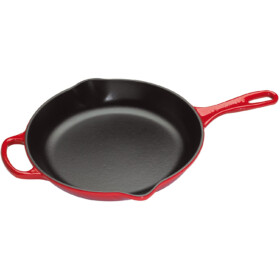
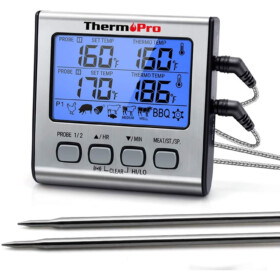
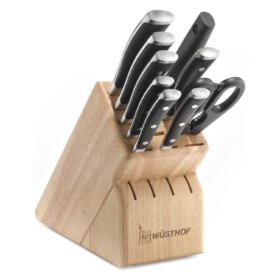
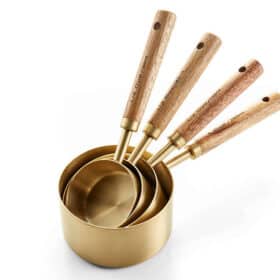
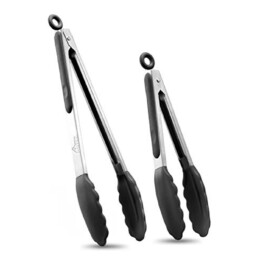
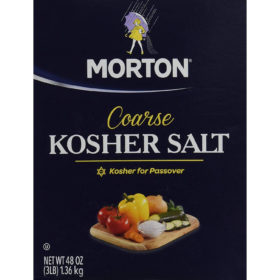

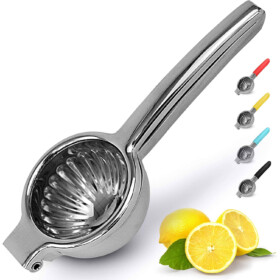
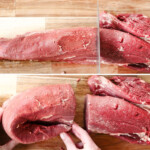
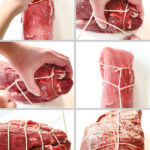

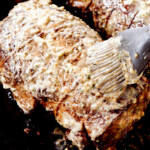

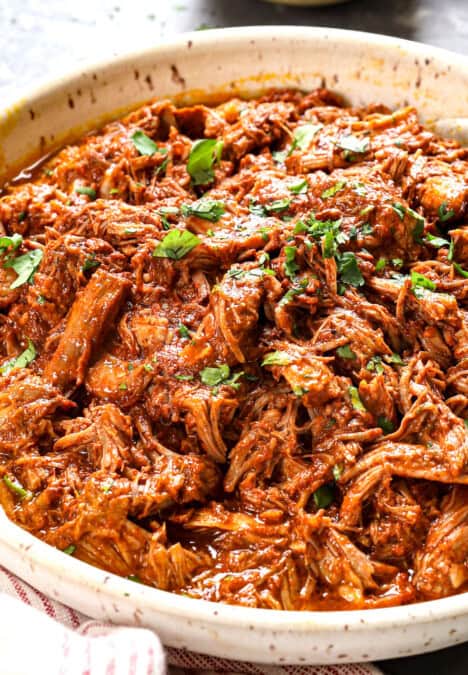
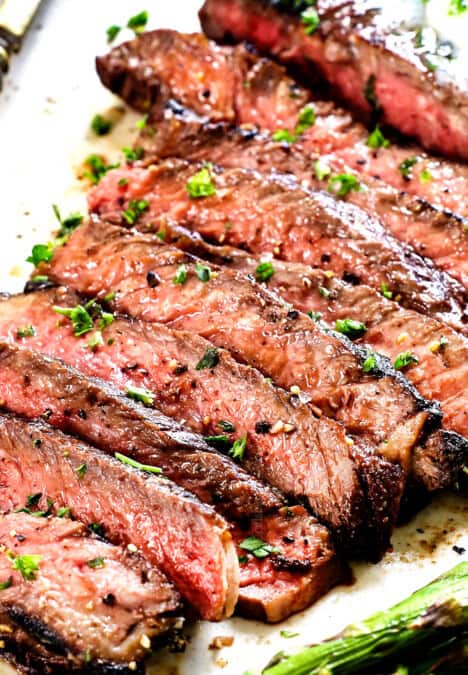

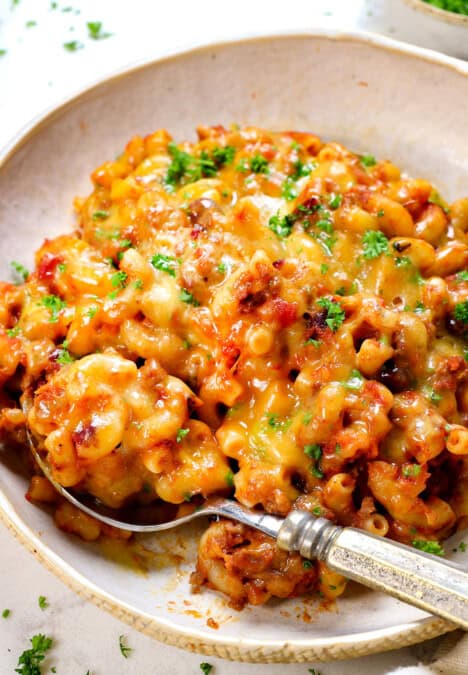

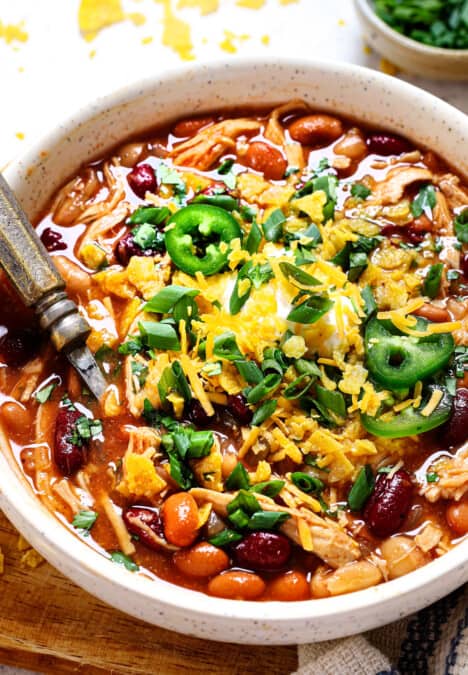























Judi Field says
Can no longer pin your recipes!. No “jump to recipe” tab and when I click on the red pinterest sign to try to save it to my board, it will not let me. HELP
Jen says
I’m so sorry Judi! It is working on my end so maybe try clearing your browser? I have a new site design hopefully launching next week which should solve any issues.
Stephanie says
Wow! Made this last night for Valentine’s dinner for the family, it was outstanding. I did adapt slightly as I used 4 filet mignon instead. Seasoned them with the spice rub (about half of it), pan seared in a cast iron skillet, finished in oven for a few minutes with a slice of your garlic herb butter which I made into a compound butter (rolled in plastic wrap earlier). I was worried the kids would detect the horseradish in the butter but they didn’t & loved it. Served with some Boursin mashed potatoes and roasted asparagus to round out the dinner. Now the horseradish cream sauce was to die for. I always make a simple one with prime rib, but your recipe with the addition of a bit of Mayo, chives and lemon juice really brightened it up. I will use the left over sauce on your slow cooker French dip sandwiches later this week which we make regularity in this house. Thank you Jen, hope you had a lovely Valentine’s Day!
Jen says
Thank you for the awesome review Stephanie, I’m thrilled you loved this recipe! I love how adept and creative you are in the kitchen – how you can take the different elements in a recipe and make it work for you! Your use of the butter into a compound butter was brilliant! I’m so pleased you loved the horseradish cream sauce as well – mayo, chives and lemon juice have never steered me wrong 😉
Kate says
I’m going to try this for Christmas and instead of using the oven to cook it, instead use the sous vide. Hopefully it works!!
Jen says
I hope so too, good luck!
Christine says
Has anyone seared meat ahead of time (morning of cooking) and then finish in oven hours later?
Jen says
That should work just fine!
Ann Rankin says
This beef tenderloin is probably the best beef I have ever tasted! This recipe beats any of the best steakhouses! I so appreciate the detailed recipe – all of the steps, necessary information & education – really makes a difference when preparing such a valuable piece of beef. My family raved and I know this will be a repeat for other special occasions! Thank you for taking the time to explain and for such a great preparation explanation!
Jen says
Wow, thank you so much for the stellar review Ann! I’m so pleased you found the information helpful and that your beef tenderloin turned out perfectly!
Jessica Ford says
I made this for Christmas dinner last night and it was amazing!!! It was incredibly easy to make and so delicious! My husband and mother-in-law are still talking about it today. I didn’t have horseradish, so I subbed in wasabi, which is essentially the same thing. Instead of serving it with the horseradish cream sauce, I served it with a gorgonzola sauce. Thanks for another amazing recipe, Jen!
Jen says
You are so welcome Jessica. I love hearing it was a talked about worthy recipe, thank you so much! Merry Christmas!
Casie says
I made this for a dinner party last night and it turned out beautifully!! I actually just re-read the recipe adn missed a few steps and it still turned out amazing!!
Thank you so much!
Jen says
You’re so welcome Casie! I’m so pleased it was a stunning hit!
Brenda says
This recipe is now at the top of our list for a Christmas dinner. It is absolutely delectable. My husband and our teenagers were trying to come up with enough superlatives to describe how delicious the beef tenderloin is. Thank you for this recipe!
Jen says
Thank you so much Brenda, I’m honored it’s a favorite! I love the visual of the “superlatives” conversation! hahaha
Amanda says
I rarely have the patience to follow recipes and prefer to wing it, but I followed this one without making any subs or changes for Christmas dinner last night and it is a PERFECT recipe.
It’s so flavorful and easy to make – and is definitely a keeper. Everyone raved about it and I love how one cut of beef can please everyone’s done-ness preferences. I even sent the recipe to my dad because he must try this gem!
I served with your smashed potatoes which were a hit as well – and finished the meal with your Nutella s’mores pie and coconut banana pie. Both pies are great for breakfast. 😉
My son requested the coconut banana pie for his birthday instead of a cake!
Now I’m thinking about tortellini al Forno for dinner later in the week.
Jen says
Thank you so much, Amanda! I am thrilled your family is enjoying my recipes and that this is a keeper – YAY!! Thanks for the awesome comment, I hope you have a wonderful weekend and find more recipes to enjoy!
Joni Schroeder says
Help! I have made this recipe in the past and we absolutely love it. I just brought home my whole beef tenderloin today and it is in the fridge with the dry rub as we speak, planned to serve it Thursday but now company won’t be here until Saturday, can I leave this uncovered in the fridge for an extra 48 hours or what should I do? Thanks
Jen says
Hi Joni, I would tightly wrap the beef tenderloin in plastic wrap and freeze until Friday, then thaw in the refrigerator overnight. Hope this helps!
Terri says
I made this for Christmas Eve dinner, and it was so good. It was super easy, probably fool-proof, and everyone loved it.
Jen says
Thank you so much for sharing your experience! I’m thrilled it was a hit!